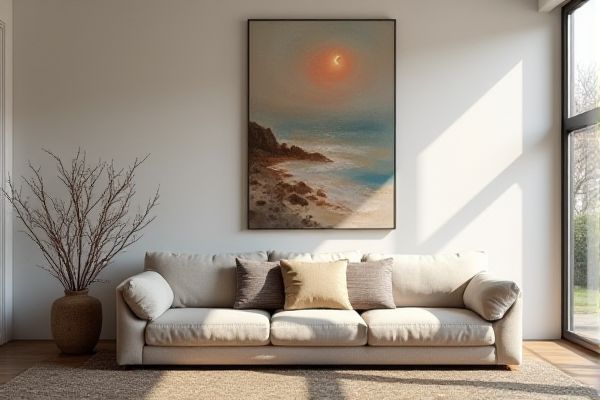
Mirrors enhance your space by reflecting light and creating an illusion of depth, while artwork adds personality and emotional expression through colors and themes. Discover how to balance mirrors and artwork for a harmonious and stylish interior in the rest of this article.
Table of Comparison
| Feature | Mirror | Artwork |
|---|---|---|
| Primary Purpose | Reflects images and light | Visual expression or decoration |
| Material | Glass with reflective coating | Canvas, paper, metal, or mixed media |
| Functionality | Practical use for grooming and spatial perception | Aesthetic appeal and emotional impact |
| Placement | Bathrooms, bedrooms, hallways | Living rooms, galleries, offices |
| Design Variability | Standard shapes, frames optional | Unlimited artistic styles and techniques |
| Maintenance | Regular cleaning for clarity | Preservation against damage |
| Light Interaction | Reflects light directly | Absorbs or reflects light uniquely |
Introduction: Comparing Mirrors and Artwork
Mirrors and artwork both serve decorative and functional purposes within a space, yet they differ fundamentally in how they interact with light and perception. Mirrors reflect your image and surroundings, enhancing spatial awareness and natural light, while artwork offers a unique visual narrative through color, form, and emotion. Choosing between mirror and artwork depends on whether you want to amplify your environment or express personal style through visual storytelling.
Aesthetic Impact: Visual Appeal and Style
Mirrors enhance aesthetic impact by reflecting light and space, creating an illusion of depth and expanding the visual scope of any room. Artwork contributes unique visual appeal through color, texture, and thematic expression, serving as a focal point that conveys emotion and style. Combining mirrors with artwork can balance ambiance and artistry, elevating interior design with both functionality and decorative sophistication.
Functional Differences: Purpose in Interior Design
Mirrors serve a functional purpose in interior design by enhancing light, creating the illusion of space, and providing practical reflection for daily use. Artwork primarily focuses on aesthetic appeal, adding color, texture, and personality to a room without serving a practical function. Your choice between mirror and artwork depends on whether you prioritize utility or decorative enhancement in your space.
Psychological Effects: Mood and Perception
Mirrors can enhance mood by reflecting natural light and creating a sense of spaciousness, which promotes feelings of calm and positivity. Artworks influence perception by evoking emotional responses and fostering creativity through colors, themes, and styles. Both mirrors and artworks significantly affect psychological states, with mirrors amplifying space and light, and artworks triggering introspection and emotional engagement.
Spatial Influence: Enhancing Room Size and Light
Mirrors enhance room size by reflecting natural and artificial light, creating an illusion of expanded space and increased brightness. Artwork contributes to spatial perception by drawing the eye and adding depth through visual layers, but it does not physically amplify light or dimensions. Strategic placement of mirrors near windows maximizes light diffusion, while large-scale, vibrant artwork adds focal interest that can psychologically broaden a room's ambiance.
Versatility: Placement and Adaptability
Mirrors offer exceptional versatility in placement, enhancing light and creating a sense of space in various rooms such as living areas, bathrooms, and hallways. Artwork provides adaptability through diverse styles and formats, allowing customization to personal aesthetics and interior design themes. Both mirrors and artwork serve functional and decorative purposes, making them adaptable elements in home decor.
Maintenance and Longevity
Mirrors require regular cleaning with non-abrasive solutions to prevent streaks and surface damage, while artwork demands careful preservation techniques, including controlled humidity and temperature to avoid fading and deterioration. High-quality mirrors often feature protective coatings that enhance durability, whereas artworks benefit from archival materials and UV-protective glazing for extended lifespan. Proper maintenance significantly influences the longevity of both mirrors and artwork, ensuring their aesthetic and functional value over time.
Cost Considerations: Budget and Value
Mirrors generally offer more affordable options compared to original artwork, making them a budget-friendly choice for enhancing your space's aesthetics. Artwork, especially unique pieces or those from renowned artists, can represent a significant investment but often holds long-term value and appreciation potential. Your decision should weigh immediate cost against the lasting cultural and emotional value that artwork provides versus the functional and decorative benefits of mirrors.
Trends in Modern Decor
Mirrors have become essential in modern decor, enhancing natural light and creating an illusion of space, while artwork adds personalized aesthetic value and cultural depth. Contemporary design trends favor large, frameless mirrors for minimalist looks, whereas abstract and geometric art pieces dominate gallery walls, offering bold color and texture. Combining mirrors with curated artwork creates dynamic focal points that balance functionality and artistic expression in interior spaces.
Choosing the Right Option for Your Space
Selecting between a mirror and artwork depends on your space's needs and aesthetic goals; mirrors enhance natural light and create the illusion of a larger room, while artwork adds color, personality, and visual interest. Consider the function of the area--use a mirror in smaller or darker spaces to open them up, and choose artwork to express your style or complement existing decor. Your choice should balance practical benefits with artistic expression to transform your space effectively.
 homyna.com
homyna.com